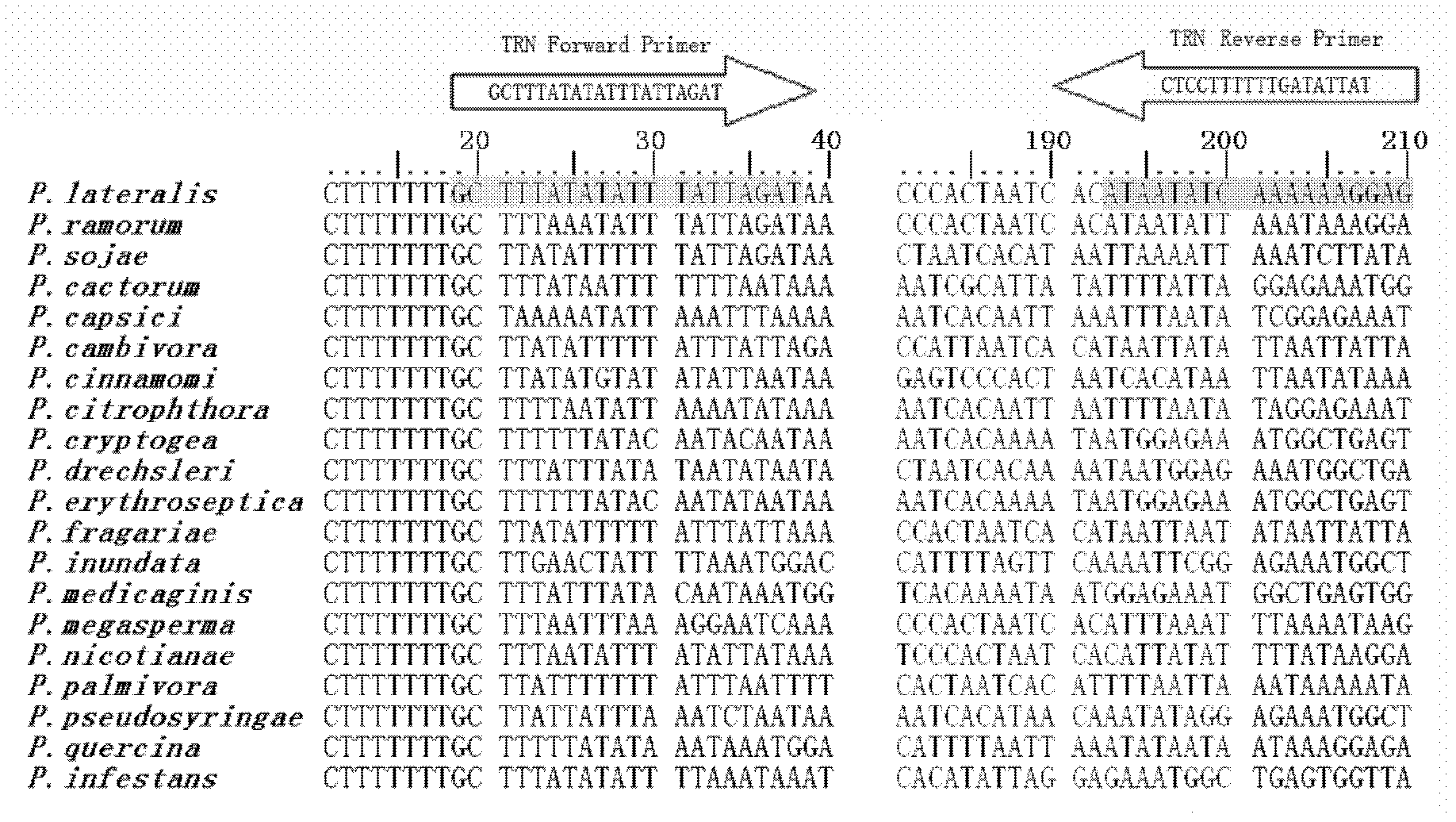Molecular detection method for Edrus deodara (Roxb) Lobd blight and primers therefor
A technology of cedar and Phytophthora, applied in the field of primers for detection of Phytophthora cedarii, can solve the problems that affect the accurate isolation of pathogenic bacteria, difficult pathogens, and complex morphological characteristics of Phytophthora
- Summary
- Abstract
- Description
- Claims
- Application Information
AI Technical Summary
Problems solved by technology
Method used
Image
Examples
Embodiment 1
[0028] Embodiment 1: design, synthesize primer and set up the PCR reaction system of cedar Phytophthora detection kit
[0029] 1. Primer design and synthesis
[0030] Design of specific primer T1 / T2: for GeneBank P. lateralis Comparative analysis with tRNA sequences in other Phytophthora ( figure 1 ), designed a pair of specific primers T1 / T2, the sequence is as follows:
[0031] T1: 5'-GCTTTATATATTTATTAGAT-3' (SEQ ID NO. 1)
[0032] and T2: 5'-CTCCTTTTTTGATATTAT-3' (SEQ ID NO. 2). The designed primers were re-analyzed by BLAST in GeneBank to verify their specificity.
[0033] At the same time, a pair of nested PCR outer primers T3 / T4 were designed, according to P. lateralis tRNA sequence, so that this primer is outside the specific primer, design a pair of outer primers T3 / T4, the sequence is as follows:
[0034] T3: 5'-GTTCGAATCCCTTTTTTTGC-3' (SEQ ID NO. 3)
[0035] T4: 5'-CAACAAATTTACAGTCTGCCGC-3' (SEQ ID NO. 4).
[0036] All primers were synthesized by Shangha...
Embodiment 2
[0043] Embodiment 2: Preparation of DNA template
[0044] Extract DNA from various samples as templates for PCR reactions. The specific process is as follows:
[0045] 1. Mycelium cultivation, collection and DNA extraction
[0046] (1) Preparation of medium
[0047] 10% V8 medium: 100 mL V8 juice, CaCO 3 0.2 g, add water to make up to 1 L.
[0048] PDA medium (Potato Dextrose Agar): 20 g of agar powder, 200 g of potatoes, 20 g of glucose, and dilute to 1 L with water.
[0049] (2) Mycelium cultivation and collection
[0050] Transfer the tested Phytophthora to V8 solid medium plate, culture in the dark at 20°C for 3 days, cut 10 pieces of 2 mm × 2 mm colony pieces from the edge of the colony, transfer to V8 liquid medium, and culture with shaking at 25°C for 5- After 7 days, the mycelium was collected by filtration, dried and ground into powder by freezing, and stored at -20°C for future use.
[0051] (2) Extraction of hyphal DNA
[0052] Take a small amount of myce...
Embodiment 3
[0058] Example 3: Detection of specificity and sensitivity of primers
[0059] 1. Specific detection
[0060] The bacterial strains used in the present invention and related information are shown in Table 1. Adopt specific primer T1 / T2 designed by the present invention to carry out PCR amplification to all test bacterial strain genomic DNAs in table 1, can only be tested from 2 P. lateralis A 192 bp band was specifically amplified in the strain, while the other tested strains and the blank control had no amplified band (Table 1, figure 2 ). Indicates that the primer has species specificity and can be P. lateralis Distinguished from other closely related species and other related species.
[0061] Table 1 The bacterial strains used for screening primer specificity in this example
[0062]
[0063] In the above table: + indicates the specific amplification band with primer T1 / T2, the length is 192 bp; - indicates no amplification product.
[0064] 2. Sensitivity dete...
PUM
 Login to View More
Login to View More Abstract
Description
Claims
Application Information
 Login to View More
Login to View More - R&D
- Intellectual Property
- Life Sciences
- Materials
- Tech Scout
- Unparalleled Data Quality
- Higher Quality Content
- 60% Fewer Hallucinations
Browse by: Latest US Patents, China's latest patents, Technical Efficacy Thesaurus, Application Domain, Technology Topic, Popular Technical Reports.
© 2025 PatSnap. All rights reserved.Legal|Privacy policy|Modern Slavery Act Transparency Statement|Sitemap|About US| Contact US: help@patsnap.com



